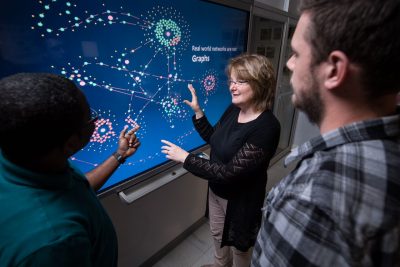Innovative Real-Time Mobility Analytics Will Be Crucial for Smart Cities
Author: Engineering Alumni Office
Posted on Apr 12, 2018
Category: Research Spotlight
Dr. Monica Wachowicz, professor and Cisco Systems Chair for Big Data at UNB, says that we can and should do a better job of extracting the value of Big Data in order to act on it and provide better user experiences, create more efficient systems, optimize effectiveness in cities and sectors, and even create more jobs. 
As the Director of the People in Motion Lab within the Engineering Faculty at UNB, Dr. Wachowicz and her team of 24 researchers and students are combining the Internet of Things (IoT) with new analytics tools to enable smart cities to create new services, applications and even new business models. “The IoT generates data points, and we’re working on ways to quickly collect this data and analyze it for new insights,” explains Wachowicz. “We’re developing breakthrough algorithms for analyzing information to assist in everything from tourism to municipal planning to energy use to traffic jams. Mapping human mobility behaviour –through phones, cars, transit, fitness monitors, smart home systems and many other things – helps us understand and design smart cities of the future.”
As an example, she and her students have been working with the City of Saint John to create smart city applications using a real-time recommender system that can enhance the tourism experience for a first-time visitor to the city. The pilot project outcomes are showing ways to improve and strengthen the tourism sector in Saint John and New Brunswick as a whole.
Wachowicz’s research, which is supported by NSERC, Cisco Systems, NBIF, ACOA, SSHRC, and Horizon2020, has been a major step toward developing autonomous analytical workflows and implementing the next generation of edge/fog/cloud computing for improving predictive models. The People in Motion Lab also plays an important role in helping students develop problem-solving, critical thinking and creativity skills that relate to the understanding and application of Big Data. Dr. Wachowicz’s undergraduate and graduate students learn to explore, clean, refine, analyze and visualize geospatial, streaming unstructured and structured types of Big Data, learning hands-on analytical and visualization tools. “Currently there are 9000 data scientist/engineer positions that need to be filled in Canada alone – there are over 20,000 in the United States. Companies are looking for talent and we are creating a critical mass of it here.” Wachowicz says. “The lab is unique in that students come from all disciplines – computer science, engineering, statistics, physics – and cluster their work to collaborate and learn from one another. They become highly skilled problem solvers.”
But Wachowicz believes that it’s not only students who should collaborate, but citizens and governments too. “There is so much economic potential that lies within data; it really is the new oil in terms of resource potential. Municipalities and governments need to be thinking not only about the data that they have today, but the new types of data that they will be collecting using the IoT. By 2025, we are going to have over 50 billion smart connected devices that will be collecting the digital footprints of our cities. If governments genuinely want to use data to support sound and actionable decisions they need to have an ecosystem in place. They need to open up more data for citizens, researchers and businesses to engage with and provide solutions and opportunities.”
To sign up for a quarterly email with more innovation updates from UNB, email engineering.alumni@unb.ca.
